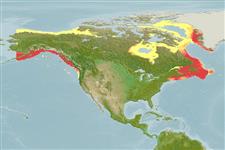Environment: milieu / climate zone / depth range / distribution range
Ecologia
marino demersale; distribuzione batimetrica 0 - 695 m (Ref. 57178), usually 60 - 150 m (Ref. 56557). Temperate; -2°C - 10°C (Ref. 56557); 84°N - 42°N, 162°W - 43°W (Ref. 57302)
Northwest Atlantic: western Greenland and Labrador in Canada to Cape Cod in Massachusetts, USA.
Length at first maturity / Size / Peso / Age
Maturity: Lm 10.4, range 10 - 10.9 cm
Max length : 22.0 cm TL maschio/sesso non determinato; (Ref. 56591); common length : 14.2 cm TL maschio/sesso non determinato; (Ref. 56591)
Occurs primarily in the lower sections of the shelf all year (depths of 80-200 m) (Ref. 41410). Inhabits sand and mud bottoms, with temperature range of -1.07 to 2.52°C (Ref. 5951). Feeds on crustaceans and bottom fauna (Ref. 58426).
Life cycle and mating behavior
Maturità | Riproduzione | Deposizione | Uova | Fecundity | Larve
Robins, C.R. and G.C. Ray, 1986. A field guide to Atlantic coast fishes of North America. Houghton Mifflin Company, Boston, U.S.A. 354 p. (Ref. 7251)
IUCN Red List Status (Ref. 130435)
Threat to humans
Harmless
Human uses
Informazioni ulteriori
BibliografiaAcquacolturaProfilo di acquacolturaVarietàGeneticaElectrophoresesEreditarietàMalattieElaborazioneNutrientsMass conversion
Strumenti
Special reports
Download XML
Fonti Internet
Estimates based on models
Preferred temperature (Ref.
123201): 0.5 - 7.6, mean 4.8 °C (based on 301 cells).
Phylogenetic diversity index (Ref.
82804): PD
50 = 0.7500 [Uniqueness, from 0.5 = low to 2.0 = high].
Bayesian length-weight: a=0.00288 (0.00125 - 0.00668), b=3.07 (2.87 - 3.27), in cm total length, based on LWR estimates for this species & (Sub)family-body (Ref.
93245).
Trophic level (Ref.
69278): 3.0 ±0.0 se; based on diet studies.
Resilienza (Ref.
120179): Medio, tempo minimo di raddoppiamento della popolazione 1.4 - 4.4 anni (Preliminary K or Fecundity.).
Fishing Vulnerability (Ref.
59153): Moderate vulnerability (38 of 100).
